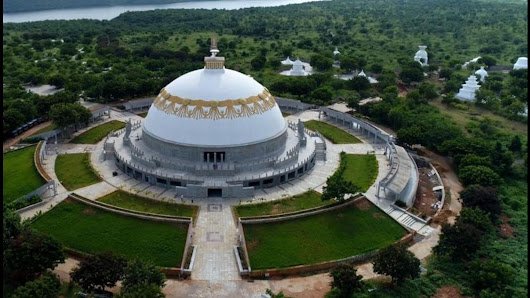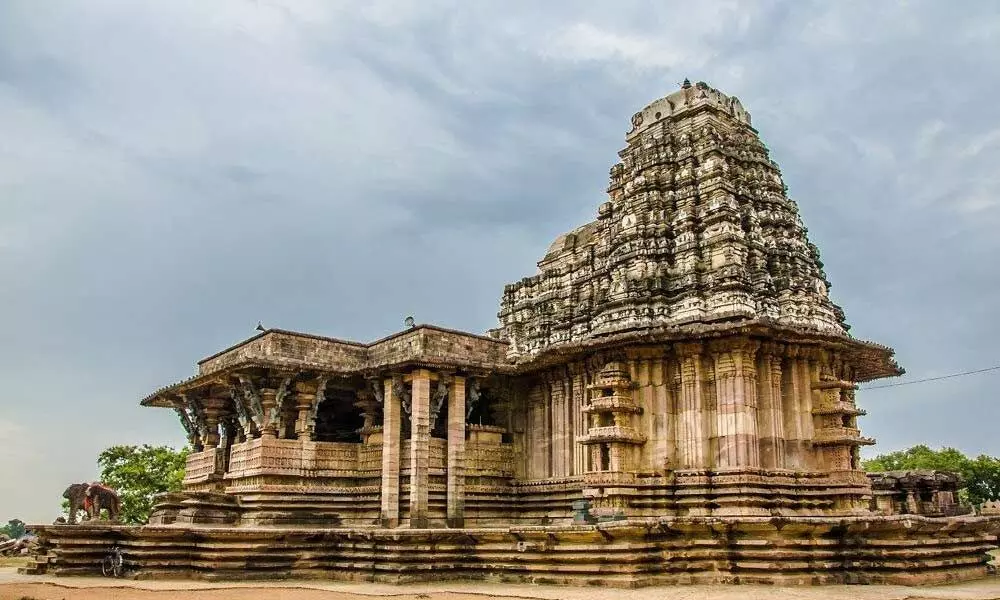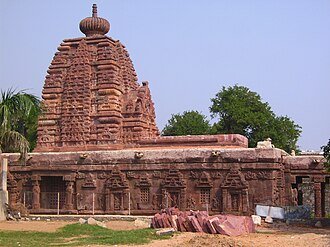
Divine Destination
BASAR SARASWATHI TEMPLE

The Basar Saraswati Temple, also known as the Gnana Saraswati Temple, is a famous Hindu temple located in Basar, a village in the Nirmal district of Telangana, India (close to Nizamabad). The temple is dedicated to Goddess Saraswati, the goddess of learning and knowledge.
Key Features of the Temple:
1. Religious Significance:
• It is one of the two prominent Saraswati temples in India, the other being in Kashmir.
• Pilgrims often perform the ritual of “Aksharabhyasam” here, where children are introduced to education by writing their first letters under the goddess’s blessing.
2. Location:
• The temple is situated on the banks of the Godavari River, adding to its serene and spiritual ambiance.
3. Historical Importance:
• The temple is believed to date back to the Chalukya period and has a mythological connection with the Maharishi Vyasa, who is said to have stayed here after the Mahabharata was composed.
4. Festivals:
• The temple celebrates major festivals like Vasantha Panchami and Navaratri, attracting devotees from across the country.o.
BHADRADRI TEMPLE
The Bhadradri Temple, also known as the Sri Seetha Ramachandra Swamy Temple, is a famous Hindu temple dedicated to Lord Rama. It is located in Bhadrachalam, in the Bhadradri Kothagudem district of Telangana, India.
Key Features of Bhadradri Temple:
1. Religious Significance:
• The temple is dedicated to Lord Rama, along with Sita and Lakshmana.
• It is considered a major pilgrimage site and an important place of worship for devotees of Lord Rama, especially during Sri Rama Navami, the celebration of Lord Rama’s birth and his celestial wedding.
2. Historical Importance:
• The temple has mythological links to the Ramayana. It is believed that Lord Rama and Sita stayed here during their exile.
• The temple was built by Bhakta Ramadasu (Kancharla Gopanna), a fervent devotee of Lord Rama, in the 17th century during the reign of the Golconda Sultanate.
3. Location:
• The temple is located on the banks of the Godavari River, surrounded by picturesque hills and a tranquil atmosphere.
4. Architecture:
• The temple has stunning traditional South Indian architecture, with intricately carved pillars and shrines.
• It is adorned with sculptures that depict scenes from the Ramayana.
5. Festivals:
• The Sri Rama Navami Brahmotsavam, which includes the ceremonial wedding of Lord Rama and Sita, is the most prominent festival here and draws thousands of devotees.

YADADRI TEMPLE

The Yadadri Temple, also known as the Sri Lakshmi Narasimha Swamy Temple, is a prominent Hindu temple dedicated to Lord Narasimha, an incarnation of Lord Vishnu. It is located in Yadagirigutta, in the Yadadri Bhuvanagiri district of Telangana, India.
Key Features of the Yadadri Temple:
1. Religious Significance:
• The temple is dedicated to Lord Lakshmi Narasimha, who is worshipped in three forms: Jwala Narasimha, Gandabherunda Narasimha, and Yoga Narasimha.
• It is a major pilgrimage center, attracting thousands of devotees from Telangana and other parts of India.
2. Mythological Connection:
• The temple is associated with the sage Yadarishi, who meditated in a cave on this hill. Lord Narasimha is said to have appeared in five different forms to bless him, which are worshipped at the temple.
3. Renovation and Expansion:
• The temple underwent a massive renovation project initiated by the Telangana government under Chief Minister K. Chandrashekar Rao.
• It has been transformed into a magnificent and modern temple with black granite (Krishna Shila) carvings, stunning gopurams (temple towers), and spacious premises, making it one of the largest temple complexes in the region.
4. Architecture:
• The revamped temple showcases traditional Dravidian-style architecture with intricate carvings and sculptures.
• It features gold-plated vimanas (sanctum towers) and majestic entrance arches.
5. Festivals and Rituals:
• Brahmotsavams, Vaikunta Ekadashi, and Narasimha Jayanti are celebrated grandly.
• The temple is also a popular site for performing Satyanarayana Vratam and other special rituals.
6. Location and Accessibility:
• The temple is located about 60 kilometers from Hyderabad, making it a popular day-trip destination.
• Pilgrims often climb the hill to reach the temple, although transportation facilities like buses and ropeways are available.
BUDDHA VANAM
Buddhavanam,
Buddhavanam – a Buddhist theme park is a prestigious project taken up on the northern bank of river Krishna in Nagarjunasagar by Telangana Government with a view to develop tourism in the State. Government of India has sanctioned the project as part of developing an integrated Buddhist Circuit with a vision to attract large number of domestic and international tourists particularly from South – East Asia.
Buddhavanam is one of its kind and the largest Buddhist heritage theme parks with an extent of 279 acres.

RAMAPPA TEMPLE

The Ramappa Temple, officially known as the Rudreshwara Temple, is a UNESCO World Heritage Site located in Palampet village near Warangal in the Mulugu district of Telangana, India. It is an architectural marvel and one of the finest examples of Kakatiya dynasty art and engineering.
Key Features of the Ramappa Temple:
1. Dedication:
• The temple is dedicated to Lord Shiva and is named after its sculptor, Ramappa, which is unique, as most temples are named after the deity.
2. Architectural Brilliance:
• Built in 1213 CE during the reign of Kakatiya King Ganapati Deva, the temple reflects the Kakatiya style of architecture.
• It stands on a 6-foot-high star-shaped platform and features intricate carvings on walls, pillars, and ceilings.
• The temple is made of lightweight floating bricks for the roof, which makes it earthquake-resistant.
• The black basalt (dolomite) stone used in the temple carvings showcases the craftsmanship of the Kakatiya artisans.
3. Key Highlights:
• Shivalinga: The main sanctum houses a grand Shiva Lingam.
• Nandi Mandapa: The temple features a majestic Nandi statue, positioned to face the sanctum.
• Carvings: The detailed sculptures depict scenes from Hindu mythology, dance, music, and daily life during the Kakatiya era.
• Sandstone Work: The ornate pillars and beams display exquisite floral and geometric patterns.
4. UNESCO Recognition:
• In 2021, the Ramappa Temple was inscribed as a UNESCO World Heritage Site, recognizing its outstanding universal value as an example of Kakatiya architecture and heritage.
5. Historical Importance:
• The temple is a testament to the engineering and artistic expertise of the Kakatiya dynasty.
• It was constructed over 40 years, showcasing the dedication of the artisans and rulers of that period.
6. Surroundings:
• The temple is set amidst a tranquil environment, surrounded by lush greenery and near the Ramappa Lake, which adds to its beauty.
7. Festivals:
• Maha Shivaratri is celebrated grandly at the temple, attracting devotees from across the region.
Location and Accessibility:
• Distance from Warangal: Approximately 66 km.
• Distance from Hyderabad: Around 210 km.
• Well-connected by road; local buses and private vehicles are available.
THOUSAN PILLAR TEMPLE
The Thousand Pillar Temple, also known as the Sri Rudreshwara Swamy Temple, is a historic Hindu temple located in Hanamkonda, near Warangal, in the state of Telangana, India. Built in the 12th century by the Kakatiya King Rudra Deva, the temple is a remarkable example of Kakatiya architecture and artistry.
Key Features of the Thousand Pillar Temple:
• Architecture: The temple is renowned for its star-shaped architecture and intricate carvings. It is a Trikutalayam, meaning it houses three shrines dedicated to Lord Shiva, Lord Vishnu, and Lord Surya. The shrine of Lord Shiva faces east, while the shrines of Lord Vishnu and Lord Surya face south and west, respectively. These shrines are interconnected by a square-shaped mandapam.
• Pillars: Despite its name, the temple does not literally have a thousand pillars. However, it features numerous intricately carved pillars that exhibit the exceptional craftsmanship of the Kakatiya artisans. The pillars are adorned with detailed sculptures and perforated screens, showcasing the architectural brilliance of the era.
• Nandi Statue: A significant attraction of the temple is the monolithic Nandi (the sacred bull of Lord Shiva) situated in the temple complex. This exquisitely carved statue adds to the temple’s grandeur.
• Historical Significance: The temple stands as a testament to the rich cultural heritage and architectural prowess of the Kakatiya dynasty. It has been recognized as a UNESCO World Heritage Site and is currently being renovated and maintained by the Archaeological Survey of India.
Visiting Information:
• Location: The temple is situated at the base of Hanamkonda Hill in Hanamkonda, Telangana. It is approximately 150 km from Hyderabad and about 6 km from the Warangal railway station.
• Timings: The temple is open to visitors from 6:00 AM to 8:00 PM. There is no entry fee.
• Best Time to Visit: The ideal time to visit is during the cooler months from October to March. Visiting during festivals like Maha Shivaratri can provide a culturally enriching experience.
Additional Information:
The temple complex is not only a place of worship but also a popular tourist destination, attracting visitors with its historical significance and architectural beauty. It is advisable to allocate sufficient time to explore the intricate carvings and the serene ambiance of the temple.

ALAMPUR TEMPLE

Alampur, located approximately 215 kilometres south of Hyderabad on the banks of the Tungabhadra River, is renowned for its rich cultural heritage and ancient temples. It is often referred to as the “Western Gateway of Srisailam.”
The town is home to the Jogulamba Temple, dedicated to Goddess Jog Lamba, considered the 5th Shakti Peetha among the 18 Maha Shakti Peethas in India. This temple holds significant religious importance and attracts numerous devotees.
Adjacent to the Jogulamba Temple are the Nava brahma Temples, a group of nine temples dedicated to Lord Shiva. These temples, dating back to the 7th century, showcase the Badami Chalukyan architectural style and are notable for their intricate carvings and historical significance.
Alampur’s temples are not only places of worship but also exemplify ancient architectural brilliance, making the town a significant destination for both devotees and history enthusiasts.
For a visual tour and more insights into the Jogulamba Temple and the Nava brahma Temples of Alampur, you might find the following video informative:
